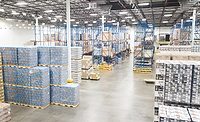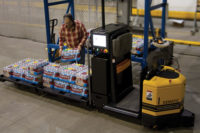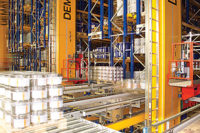“I don’t think the SKU proliferation game is going to slow down anytime soon,” says Lonnie Watkins, strategic account manager of integrated systems with Dematic North America, Grand Rapids, Mich. “… SKU proliferation is a big deal and just the pure volume of product that some of these warehouses are trying to move now; because of that, we’re seeing larger spaces, and we’re seeing desire for them to find more efficient ways to move that product into their operations and get into the trade.”
Efficient focus
As the number of new products and SKUs increase, so do consumers’ demands.
“Anybody who’s tried to rationalize their product line has found that they lose sales because consumers, even though they’re challenged money-wise, they don’t want to give up their demands for their niche products,” says Bill Leber, director of business development and marketing for Newport News, Va.-based Swisslog North America. “They’re not willing to give up the product to save money.”
Growth from niche products is requiring additional flexibility from warehouses to deliver more variety through mixed-SKU pallets. Because of the increasing demand for mixed pallets, distributors and manufacturers are tasked even more to be efficient.
South Bend, Ind.-based Twinlode works with companies to help reduce the handling cost that they have by storing product in a more efficient manner and laying out the warehouse so that products are readily available to either pick for mixed pallet shipping or allow full pallet loads to be processed and shipped, says President Skip Eastman. Twinlode offers its Pallet Rack & Storage System, which features a double-wide design that allows warehouses to load and unload two pallets at a time.
“We try to help them be very flexible because what they have in their warehouses today may not be what they have two years from now,” he says.
To find the most efficient way to handle the increasing SKUs and demands for mixed pallets, more warehouses are turning to technology — particularly software. The advancements of software now compared to 15 years ago have improved greatly with regards to package tracing, tracking, identification as well as camera systems, Dematic’s Watkins says.
Assisting order fulfillment, Dematic’s software program PickDirector takes order information directly from a company’s computer system and delivers it to the picker. PickDirector’s hardware and software technology eliminates tasks such as reading, writing and searching for stock locations, the company says, and has shown productivity improvement while reducing picking errors.
Different levels of warehouse management system (WMS) solutions also continue to help increase efficiency. Dematic offers WMS solutions to help warehouses reduce inventories, manage orders, increase delivery reliability, decrease picking errors to help lower correction costs, and lessen efforts in return handling, it says.
At the same time, technological advancements with WMS solutions have helped the software components become more readily available to varying sizes of warehouses.
“The advancement of technology has been wonderful for the large, medium, small, whichever segment of warehousing is out there,” Twinlode’s Eastman says. “… The warehouse management system is easier to work with, easier to maintain and is more readily available than it used to be in years past.”
Both conventional warehouses and those with an automated storage and retrieval system (AS/RS) can benefit from a WMS solution, particularly when it comes to assembling store-ready pallets that are composed of mixed SKUs, suppliers say.
“The integration of AS/RS and WMS with palletizing and order sequencing means automation can provide store-ready pallets,” says Laura Worker, marketing manager for Westfalia Technologies, York, Pa. “Our recent installation at [Pepsi Beverages Co.] is an example of integrating both full layer and mixed layer palletizing to build store-ready pallets. The store-ready pallets can then be loaded on delivery trucks in the truck’s stop order for faster delivery times.”
Westfalia offers its Savanna.Net WMS software, which introduced its 2.3 version at ProMat 2011. Key features of Savanna 2.3 include real time 3-D visualization of the warehouse, a dashboard for tracking key statistics of warehouse operations, streamlined user rights management interfaces, and improvements to the order picking module for integrating third-party picking solutions, such as high-speed layer picking and mixed layer picking, the company says. Savanna 2.3’s 3-D visualization allows users to view the warehouse from any angle, including walking through it. Individual SKUs and warehouse zones can both be identified and filtered.
“A good WMS will manage movements really well and manage work really well in the warehouse,” says Jon Schultz, vice president of business development for Westfalia. “It plays [into] complexity. As orders get more complex, you carry more products in your warehouse and maybe less of each individual product, but more products in general. Your order quantities get smaller, so as your order quantities get smaller your efficiency will go down, and a good WMS will optimize the efficiencies of all your movements whether with automation or with manual labor.”
Earlier this month, Cincinnati-based Intelligrated showcased its latest software technologies at Modex in Atlanta. The company demonstrated its InControlWare warehouse control system, which is able to monitor a range of software products from material flow control to order and wave execution to machine control for automated material handling systems, the company says.
Automation domination
As various sectors throughout the beverage industry see an increase in consolidation, supply chain manufacturers foresee that more companies will turn to automation for their warehouse storage systems.
“I see a larger number of companies in various sizes looking at how they can automate their systems,” Twinlode’s Eastman says. “Now, understanding that some warehousing people have a manual process for their inventory, I see them expanding that into software and integrating their handling. For example, the lift trucks end up with a scanner to scan products as they go out of the warehouse or into the warehouse, so inventory control is much improved.”
Swisslog’s Leber also foresees a serious upgrade in the use of automation for the beverage industry. Leber says in the United States, the beverage industry is a few years behind its counterparts in Europe in addition to the American grocery and food industries on the level of automation.
“As those smaller distribution centers start consolidating, then they get larger and suddenly they are excellent economic drivers to put some money into automation, so that’s why we think there’s going to be some shake out in that industry,” he says.
Because of the capital expenditure that can be associated with AS/RS solutions, adoption typically can be found in larger warehouse facilities that are looking for a reasonable return-on-investment (ROI) and to help them avoid auxiliary storage or facility expansions.
“Once you get to that mass and you can start seeing some significant returns on your investment from labor savings, then [automation] starts to become attractive, and there’s a whole litany of other things that can go into the ROI analysis,” Dematic’s Watkins says. “We can talk about energy savings for bigger facilities. We can talk about product damage for bigger facilities. We can talk about workplace safety and the insurance expense that goes along with that. So if we can get to the point where we can start a feasible, reasonable ROI based on labor, then we have a lot of other opportunities to start looking at savings for efficiencies and other things.”
Arden, N.C.-based Vertique, a business unit of Illinois Tool Works (ITW) Warehouse Automation, offers scalable automation with its Vertique Systems. The customized system features a vertical design of towers that are designed to maximize warehouse space and minimize the amount of labor needed, the company says. Lines can be converted to accommodate products and pallets of different sizes. Vertique’s cascading system also has a 99.9 percent rate of accuracy, the company says.
Although having a large critical mass can make the transition to an automated supply chain a logical process, small warehouses still face many of the same challenges that larger ones do, such as SKU proliferation, requests for mixed pallets and limited floor space to store product.
“We appreciate the opportunity to advise our clients regardless of the size of their company,” Dematic’s Watkins says. “If somebody’s interested, we have very inexpensive systems in terms of assisted picking systems and things that really don’t require that big of a capital expenditure. They can essentially make more efficient the manual operation that they’re already doing, all the way up to lights-out fully automated systems.
“At each level of size and operations there’s probably something we can do to help them, and even if there’s not really anything we can sell them to help them we give them analysis and maybe peace of mind that the way that they’re doing business is as good as it can be for what they have,” he continues.
Weight struggles
Changes to packaging also are contributing to storage limitations. Consumer packaged goods companies are finding ways to lightweight products’ primary packaging, which used to be a critical part of the structural integrity of the pallet load, Westfalia’s Schultz says.
“As this lightweight packaging movement started about 5 or 6 years ago, we’ve seen that you can’t stack the product anymore, so a warehouse that used to have an average pallet stacking height of three or four is now two or less,” he says. “You basically cut the size of your warehouse in half because you store much less product in your warehouse because you can’t stack it anymore.”
The integration of a dense racking system as well as different forms of automation are some of the ways supply chain manufacturers can help make up for lost floor space. Westfalia’s Satellite rack entry vehicle can store pallets up to 12 deep in a rack storage lane, the company says.
Westfalia’s systems also can be integrated into conventional beverage warehouses, which can be low-bay operations that are only 20 to 40 feet high, Worker says.
“Our high-density AS/RS and WMS storage solutions can double or triple storage capacity in an existing facility, thus solving the storage problem created by the inability to stack pallets of products,” she says.
In order for dense racking systems and automation to work within a smaller facility’s ROI timetable, storage system suppliers seek to find the right scale of the system to be applied.
“The biggest problem that I see is [small warehouses] have a small amount of space dedicated for their products, so we try to take them into the next generation in storage,” Twinlode’s Eastman says.
“… They’re just applied at a different scale, making them as efficient as possible with the right equipment being installed in their facility.” BI






